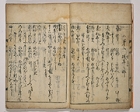Japanese Gallery (Honkan) Room 16
March 17, 2009 (Tue) - April 19, 2009 (Sun)
Modern Japanese cuisine is a result of customs which developed in Japanese culture over many centuries. Narrative picture scrolls from the middle ages show that court nobles and warriors historically ate rice as their main dish, accompanied by dried seafood and salt-preserved dishes. The refinement of the dishes which traditionally accompanied rice resulted in the Japanese cuisine we know today.
While little is known about the daily meals of common people, we do know that skilled knife handling and the appearance of served food were important for dishes served on ceremonial occasions. The Muromachi period (1392-1573) saw the emergence of schools of cooks who worked exclusively for the imperial court or shogunate, and developed secret techniques which were transmitted through generations. The development of tea ceremony in turn led to the creation of kaiseki cuisine, where serving food hot come to be viewed as a form of hospitality.
In the Edo period (1603-1868), practical cooking books (including Practical Narrative of Food Preparation) began to be published, and the influence of foreign cuisine resulted in the use of cooking oils and the inclusion of chicken and fried food in culinary repertoires. The spread of cooking techniques and utensils as well as the full scale production of soy sauce further enriched the variety of Japanese cuisine.
From the mid-Edo period, restaurants began to emerge across Japan, reflecting a new trend toward enjoying food as recreation, and the spread of sugar and eggs caused an increase in the variety and richness of sweets. The publication of commercial cooking books rapidly increased in the Bunka (1804-1818) and Bunsei (1818-1830) eras of the late Edo period, thus adding to these developments. This exhibition looks at the history of Japanese food culture, as seen through some of these early cooking books.

